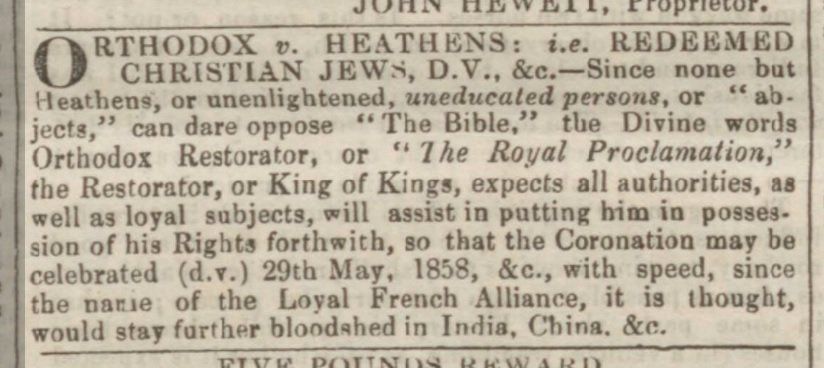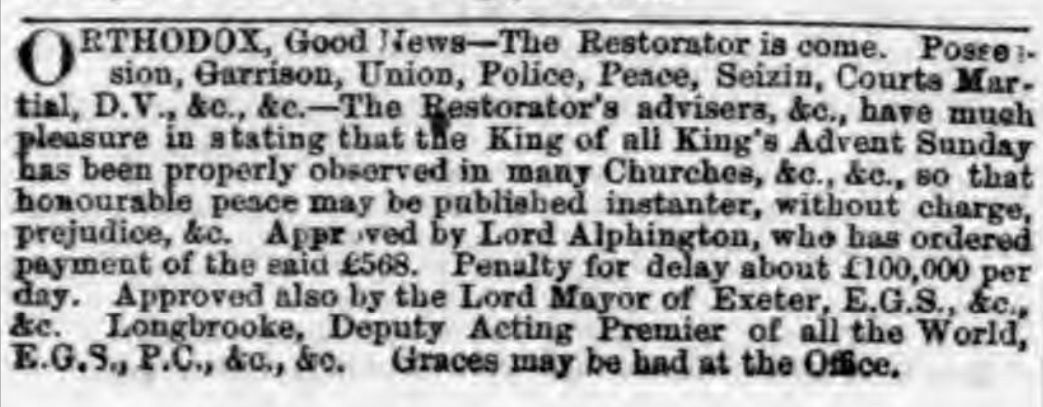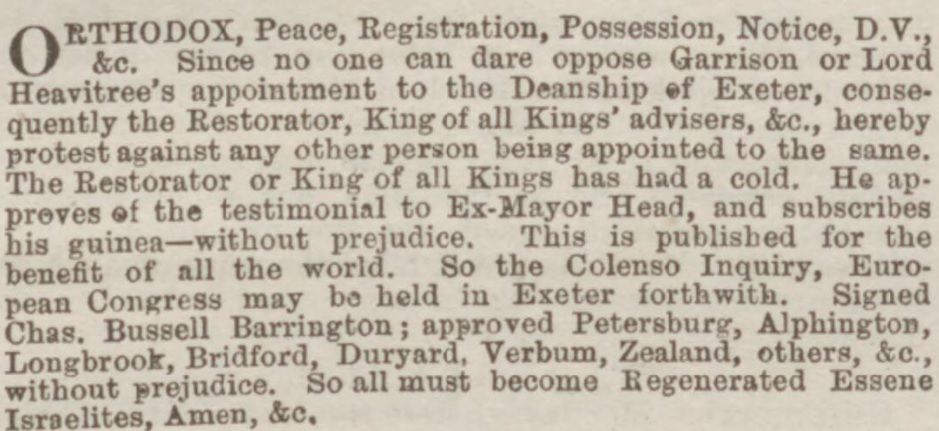Rev Charles Rookes
Rev Charles Rookes was born in Exeter in 1798. His parents Robert and Mary lived on a farm on the Topsham Road near Countess Weir. He was baptised at Heavitree. (Heavitree Parish at that time stretched from Countess Weir to Whipton.) After his father died in 1821, his mother moved to Hill’s Court, off Longbrooke Street in Exeter, where Charles was to spend most of the rest of his life.
Charles was educated at Jesus College, Cambridge, graduating LL.B. in 1824.
In 1823 he was appointed Curate in Stawley, Somerset.
In Jun 1829 he was appointed Rector of Teffont Evias, in Wiltshire. That November, aged 31, in Bath, he married Mary Rudsdell (1792-1878), daughter of the late Capt Richard Rudsdell RN and his wife Easter. He resigned from his position in Teffont Evias a year later.
The couple separated in April 1831; he seems to have returned to Exeter while his wife thereafter lived in Bath with her mother. In July that year their son, Charles Arthur Rookes was born. He died aged 21 in Demerara, Guyana.
In Easter Rudsell’s will dated 1838, she claimed that her son-in-law Rev Rookes had broken his “sacred promise” to repay her money owed from the time he and her daughter were married.
Rev Charles Rookes was inducted Rector of Nymet Rowland in November 1837 by the Bishop of Exeter, in succession to Rev John Arundel Radford (who had resigned) on the presentation of the patron, his brother Lewis Arundell Radford, a druggist then of Beeston, Nottingham.
In 1825, Rev John Arundel Radford (“Parson Jack”) had been appointed Rector of both Nymet Rowland and Lapford, on the death of his father Rev William Radford. Rev William left considerable debts and after a protracted series of court hearings in London, in 1837 his assets had to be sold off. His assets were deemed to include the advowsons of both parishes. Exeter solicitor (and clergyman’s son) William Henry Tanner (1791-1871) was one of the creditors, and acting on behalf of a group of creditors, arranged the sale of William Radford’s assets. He himself bid for and bought the advowsons, just after Rookes was appointed. Rookes allowed Tanner the tythes income in return for an undertaking that Tanner would indemnify Rookes against the cost of restoring the dilapidated parsonage. This was deemed unfit for habitation by the Bishop, so Rookes lived in Exeter.
His induction to the living was one of the few times that he was present in Nymet Rowland. There are no records of his ever conducting any baptisms, marriages or funerals there. The services were conducted by a curate, and for about ten years from 1841 this was Rev Henry Allwright Hughes of Clannaborough.
On 11 April 1838, charges were laid against Rev Rookes at Bath of having assaulted and ill-treated his wife. “…when she was pregnant he told her that hell had conspired against him that he should have children, that told her to get rid it, that he would send for the nurse and undertaker at the same time, that he struck her and squeezed her for the purpose of destroying the child, that he told her with execrations that if she would have children she must get up and work for them, that he made her take long walks for the purpose of procuring abortion, that she was obliged to leave him, and went to live at her mother's, that he came with violence to the door … and on his promising to refrain from violence, she consented again to live with him, that he afterwards threatened to handcuff her and drag her round the town, that he went for handcuffs and put them on his wife and dragged her round the room, much injuring her wrist and leg, and other acts violence.” He was found innocent.
A year later in Exeter Consistory Court his wife with this allegation of cruelty unsuccessfully sought a divorce.
Between 1838 and 1849 Rookes conducted one or two marriages each month at St Mary Steps Church in Exeter.
In 1848 he obtained the degree of LL D from the University of Giessen, Germany.
In January 1849 he purchased the advowson for St May’s Steps, Exeter, thinking he would also be a rector in the city but a few months later a court case put paid to his ambitions.
“SEDUCTION BY A CLERGYMAN”
At the Devon Lammas Assizes held in July 1849 in Exeter, Rev Dr Charles Rookes was sued by Mary Brook, a poor widow in her sixties of living in Bear Street between South Street and Exeter Cathedral. She alleged that Rookes had seduced her second daughter, Maria Mary.
For six years from 1842, when she was about 26, Mary had been employed by him as a servant. In January 1844 she had a baby who survived only three days; she claimed that Rookes was the father. She said that he had promised to maintain her, and to marry her should his wife die. However she stated that he then took a fancy to someone else, and dumped her back on her poor mother. Her mother was now claiming for the loss of her daughter’s services resulting from the seduction. Rookes was defended by Tanner but lost the case and the jury ordered him to pay the girl’s mother £100 damages.
Why they waited five years to bring this action is unclear, but it seems probable that the Brook family were encouraged to take this action by others, perhaps in connection with the Mary Steps living.
Predictably the Church authorities got to hear and in September 1849 he was charged at Exeter with "offences against the Laws Ecclesiastical, by having been guilty of adultery, fornication, or incontinence, and other irregularities and excesses, within the diocese; whereby he had brought great scandal on the Church".
Having studied the details of the assizes case, the Bishop’s verdict in November was that Rookes should be deprived of the living at Nymet Rowland (and anywhere else in his diocese).
1849 EXETER - THE GREAT FIREWORK FESTIVAL.
All the world knows that the Fifth of November is celebrated in this city as a local festival for the juveniles of all ages-and that that everlasting young fellow, Mr. Eyre Kingdon [later to marry Rookes’s niece] generally provides some special fun for the occasion— the basis of which happens to be a topic of public interest for the nonce. The Cathedral-yard is the scene of action - squibs crackers, and hand rockets are let from dusk till midnight, and the materials of a bonfire are ordinarily built up in the early part of the day, and set fire to about ten o'clock … On the present occasion Brooks against Rookes, formed the moral of the night's proceedings. Rookes had seduced Brooks, and Brooks had "pulled up" Rookes … The venerable fathers of the chapter had also mumbled over the dirty details, within their sacred precincts—so the youngsters of all ages determined to have their turn with the enormity. At about ten of the clock, a procession entered the yard lighted by torches. It was a grotesque affair, in which maskers, in every state of guys and disguise proceeded round the yard, with music, and a band of torch bearers. High above the heads of all —was the figure of a Rook, with clerical bands, and by the side that black bird, was the figure of frail young girl from the Rookery. These effigies were taken in due form, to the top of the pile, and there most remorselessly burnt.
With Rookes deprived of the living, Tanner, the Patron of Nymet Rowland had to find a replacement. The Curate of St Thomas, Exeter, Rev Thomas Rutherford Dickinson (1811-1870) expressed an interest. Tanner offered him the position and the advowson for about for about £1000. The advowson was only worth between £200 – 500, implying that Dickinson, who borrowed the money, had paid over the odds to become Rector. This constituted the offence of Simony, as buying a living in the Church of England was prohibited. Rookes was quick to point this out to the Bishop, who instituted an enquiry. Dickinson, who had been the rector for two years was kicked out in 1852 and around the same time went bankrupt. In 1860 in Surrey he was jailed for bankruptcy. Tanner the solicitor was criticised and ceased practising soon after.
Around 1855 Rookes started issuing proclamations, and frequently inserted advertisements in the local papers claiming to be “His Most Sacred Majesty Charles the III”, and “The orthodox Prince of Peace on Earth.” Some examples below:



EGS is the abbreviation for the "Eden Garden Society" - his name for the Exeter Oddfellows (a friendly society).
Petersburg, Alphington, Longbrook etc are nicknames Rookes used for his friends and acquaintances.
Rev Dr Charles Rookes died on 23 Nov 1867 of bronchitis, at his home in Hill’s Court, Exeter. He was buried at Heavitree. He signed his will three days before his death – leaving most of his £6000 estate to his nephews and nieces. The will had been drawn up by John Eyre Kingdon, a wealthy farmer who nine months earlier had happened to marry Clara Rookes, one of the nieces. (She was his second wife; he was 59, she was 34. She was also his son’s wife’s sister). Rev Rookes left £50 for his estranged wife Mary in Bath. She then sued for a greater share, on the basis of his mental state at the time of writing the will. The case was heard in London, with about 60 witnesses from Exeter attending. On the third day of the hearing the parties agreed that she would get 25% of the estate remaining after the expensive lawyers’ fees had been deducted, the remainder going to the nephews and nieces.
Was Rookes mad or eccentric?
Clearly Rookes was a very strange individual. He was ostracised after the revelations of his relationship with his servant Mary Brooks
led to him being deprived of his living. It was then that his behaviour started to become extreme. He seemed fairly harmless and the public quite enjoyed his eccentricities. He was often suing people in court, where he was very long-winded, and generally lost. At the hearing into the disputed will, it was claimed that despite calling himself “King of Kings” and “Restorator” he had some insight. Furthermore he managed his finances well. Dr Boughton Kingdon (an Australian born homeopath) was Rookes’s physician, and asserted that he was of sound mind when he signed the will.
